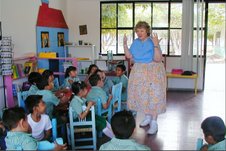On this trip we explored the Mummy Museum (Museo de Momias) and had a personal tour by the docent. It houses about 15 mummies as well as several very, very old paintings and religious objects found in the area. The docent explained there is something in the earth that naturally mummifies a corpse.
We also toured the city cemetary. You may think it unusual to go to a cemetary, but in Mexico the cemetaries are very different from those in the USA. This cemetary has vaults in the walls as well as the white statues in the graveyard naming the families buried there.
In another small museum in La Chona, I learned about the Cristero War. In 1926-29 there was an uprising and counter revolution against the Mexican government, set off by persecution of the Catholics. The rebels called themselves "Cristeros" because they said they were fighting for Christ. Many people were killed in the war which was ultimately ended by diplomatic means with the help of the US Ambassador to Mexico.
La Chona, much like AGS, is known for its handcrafts: embroidery, crocheting, knitting, and serapes are woven and sold there. They also make pottery and stained glass. There is a bullring where bullfights are held in February and occasionally charrerias--the roping of cattle and fancy horseback riding done by the charros.
In August the people of La Chona are looking forward to the celebration of the 250th year anniversary of their town.
Maria Chuy, Rosario's sister, crochets, embroiders, and knits beautiful things. She showed me tablecloths, placemats, blankets and doiles that she made and she presented me with a pretty placemat and a fancy handtowel that she had decorated. I observed that while sitting quietly the women's hands are constantly busy doing some sort of needlework. The lady who sold tickets to the museum was embroidering a set of placemats and her friend was knitting a baby blanket. The women of La Chona are proud of their handwork.
On Saturday evenings you will see many people on the plaza, sitting on benches eating Pan Dulce, a tradition in the town. Children are playing and teenagers are circling the plaza in their pick-up trucks and cars. A typical small town Saturday night!
This is the view of La Chona from Maria Chuy's house on the hill.

Nopales cactus grows in Maria Chuy's backyard. You can see how tall it gets by my standing next to it.

The Mexican people eat Nopales in several different ways. It is good in a salad, with scrambled eggs, and as a vegetable with dinner. I like it very much. Mr. Neat---watch out! You just may have an ensalada de nopales when I get home!
Maria Chuy is cutting some Nopales for our dinner.

Rosario has cut off the "prickles" and is chopping nopales for salad.

This is the Museo de Momias.

The chapel in the city cemetary.

Vaults in the walls decorated by the families.

The cemetary in La Chona.

Some of Maria Chuy's handwork.


Vaults in the walls decorated by the families.

The cemetary in La Chona.

Some of Maria Chuy's handwork.

Embroidered roses on a tablecloth.


Hasta luego.

1 comment:
I am interested in spending the next three years in la chona. I presently teach English here in Aguascalientes.
Do you know of any English positions open or available there? I would love to hear from you.
Thank you!
Post a Comment